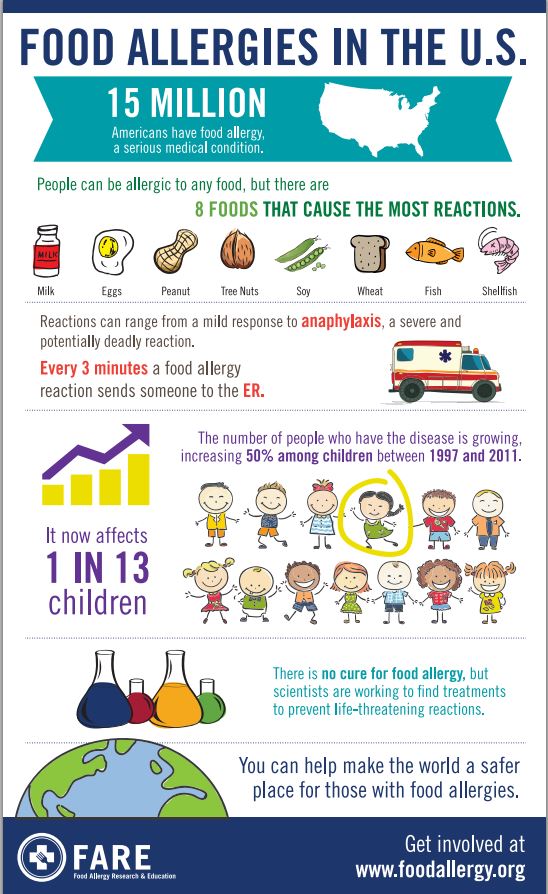At one time or another in a person’s life, they will have some kind of food allergy.
Some foods are naturally gassy, such as broccoli, onions, beans and such, but that doesn’t mean you are allergic. People who don’t eat spicy foods on a regular basis, and then go out and have a really spicy Mexican dinner, for an example, may have an adverse effect later on, maybe some stomach cramping or diarrhea, etc. This too doesn’t necessarily mean you are allergic to spicy food, it just means that your body isn’t used to the peppers and seasonings.
Some of the most common food allergies, especially in children, are allergies to the proteins in milk.
This is different than being lactose intolerant, because lactose intolerance means that you lack an enzyme in your intestinal track that has problems breaking down lactose. Milk allergies usually start in infancy, and include hives, skin irritations, and trouble breathing. Some of these can be so severe they are life threatening.
 There are other allergies to food as well.
There are other allergies to food as well.
They can include allergies to peanuts, and nut products, shell fish, fish in general, soy, wheat, just to name a few. While many of these are outgrown, some of them remain allergies throughout your life, like shellfish and peanuts.
Some of the different symptoms of food allergies are flushing, hives, swelling of the area around the mouth. Others include wheezing and coughing, having a hard time breathing, and even vomiting. Some of these symptoms occur immediately after ingestion, others can take up to an hour to appear.
In severe cases, people can go into anaphylactic shock, a life threatening reaction.
The symptoms for this are a swelling and constriction of the throat, flushing of the face, and swelling of the tongue. If this happens, you need to call 911 right away, and get medical attention immediately.
While there are five different kinds of diagnostic tests that can be done, one of them is really a look at your family history. No matter how small of a reaction, you should go to the doctors as quickly as possible, the best time is when the reaction is happening. It will begin with an examination, as well as talking about any history of food allergies in the family. It is also about knowing what kinds of foods were eaten, when the symptoms began, and what environmental changes may have been experienced.
There is the prick or scratch test, which is used to test a number of different allergens at one time. An area of the back or forearm skin is isolated, and subjected to different pricks or scratches, then marked for each different kind of allergen. If the area reacts, it will show up as a wheal or hive.
If the test is inconclusive, the next step is performed.
RAST or radioallergosorbent test is a blood test that looks for IqE antibodies in the blood, these are given when the skin test is inconclusive, or when the patient is really young or has an already existing skin condition. It is also used when there is a high risk, like a severe reaction.
There is also the elimination diet, which is effective because you are giving a specific diet of the foods that are believed to cause the allergen, and different foods are added until the reaction takes place. This also goes along with the oral food challenge, which is riskier, and needs to be done under close doctor supervision.
A common food allergy is from gluten.
Gluten is a protein that is found in grains such as barley, wheat and rye. Probably most familiar to you as the substance that is helpful in holding together dough, for bread and other baked goods. You may be surprised to find out many people suffer from food allergy symptoms and not even know it!
Unfortunately, many people are allergic to this protein and cannot tolerate ingesting it. For those who are severely allergic, a reaction can be life-threatening.
Yet, another gluten-related condition is Celiac Disease, which is passed from one generation to the next. Symptoms occur when a person who has the disease eats any food that contains gluten. At that point, the immune system attacks the small intestine and hinders the digestive process.
In both of these cases, intake of foods which contain gluten must be avoided. One of the biggest problems with identifying these foods is the fact that these grains are used to process many other types of ingredients… making the gluten much harder to identify.
Besides avoiding products that contain barley, wheat and rye those with gluten allergies need to pay close attention to package labels, as well. Be on the lookout for the following:
- Hydrolyzed Vegetable Protein otherwise referred to as HVP, unless it has been manufactured from corn or soy.
- Soy sauce products that contain wheat.
- Modified Food Starch, unless it has been manufactured from potato, corn, arrowroot, tapioca or maize.
- Cereal and flour products unless they have been derived from soy flour, potato flour, corn flour or rice flour.
- Most types of Vegetable Gum
These are just a few things to be aware of. You should also avoid purchasing products, which refer to starch, emulsifier, stabilizer, flavoring and hydrolyzed plant protein on their packaging.
Other categories of foods, which should be avoided are soup bases, beer, coating mixes and croutons, lunch meats, imitation bacon and seafood, candy, marinades, vitamins and supplements, over-the-counter medications.
Suffering from a gluten allergy doesn’t mean that you have to eat bland foods.
There are just as many foods you can eat, as those you can’t. Fresh fruits and veggies, eggs, fresh beef and pork, most types of cheeses, ice cream, tuna and other seafood, coffee, tea and soda are just the beginning.
A food allergy diet can have two objectives: Either to help you avoiding the food that triggers the allergy, or to help you determine the food that is causing the allergy in the first place.
Low Allergen Food Allergy Diet
This is an exclusion diet. This means that it is an attempt to exclude most foods that are known to cause allergic reactions. It does so without restricting your diet in an excessive way, it also restricts processed foods which may contain trigger foods in their composition.
The diet’s food restrictions include: yeast, eggs, milk and diary products, artificial sweeteners, margarine, coffee, tea, alcohol, chocolate, vinegar, sugar, syrup, jelly, salty snacks, wheat, oats, rye, corn, barley, food additives, coffee substitutes, smokes foods, salted foods, carbonated drinks, fizzy drinks, fermented products and citrus fruits.
For the majority of people this means getting rid of food that they have been accustomed to eating all their lives. Entering a food allergy diet is a major lifestyle change. As with any other type of diets, it is great if you follow some tips, like staying full by eating various meals a day and keeping a diet diary.
After a few days of following the diet, you may find that the reactions are starting to disappear, once they are gone, you can reintroduce food and observe if it produces any reaction. If nothing is observed you can again eat that specific food, but if any reaction appears, it will be strictly banned from your diet.
This may sound like a slow process but it is the best way to determine any allergy and avoid the risks of severe food allergy symptoms.
A food allergy test can help you determine if you suffer from an allergic reaction to a certain type of food.
There are millions of people allergic to food, so these tests can give you pretty accurate results that can save your life. Remember that severe symptoms can lead to death if not treated quickly.
Types of Food Allergy Tests
Testing can be done by blood tests, or skin tests. A common type of test for food allergies is the RAST test. This will help you find the presence of IgE antibodies. The skin test is done by injecting an extract of the possible foods that trigger the allergy and then observing the reactions. It is also injected an extract of the most common types of food that produce allergic reactions: milk, wheat, corn, soy, chocolate, tomato, pork, citrus, eggs and tree nuts.
Delayed Food Allergy Tests
There are many food allergy symptoms that don’t show up immediately after ingesting the “trigger” food. This is when delayed food allergy tests are useful. They measure the amount of IgG4 levels in serum that reacts to dozens of foods.
These tests show you the foods that cause the reaction even hours after eating them.
Where to Find Food Allergy Tests
Food allergy tests are found in hospitals, and in specialized clinics that have special tests for an increased amount of food types. You can find these clinics and services available in your area through the Internet. Their sites have more information about their testing methods.
Food allergy recipes exist to give allergic people an alternative to food they can’t eat because of the condition and its risks. One of the worst things about having food allergy is that you have to restrict yourself from food you love; sometimes you need to restrict a lot of foods, making alternatives even more desirable.
The recipe you choose has to be based on the type of food allergy you have, you will usually find different recipes for different restrictions.
The best way to find multiple food allergy recipes is the internet.
A simple search can return many sites dedicated to collecting a variety on recipes with different restrictions. You can also find and discuss recipes in food allergy related forums. These places are great to exchange information. Maybe you could create your own recipes!
Finally, you can find books both physical and electronic filled with recipes for allergic people. These are great resources that save you the time of digging in the Internet for a suitable recipe.
Although food allergy symptoms can sometimes be mild and only annoying, there are cases when the symptoms can be severe, one of them called anaphylaxis (a sudden drop of blood pressure) can be fatal. It is important then that an allergic person restricts the problem foods and try to replace them with alternatives that are not harmful.



